|
Moon with a View:
Or, What Did Arthur Know… and When Did He Know it?
Part 6
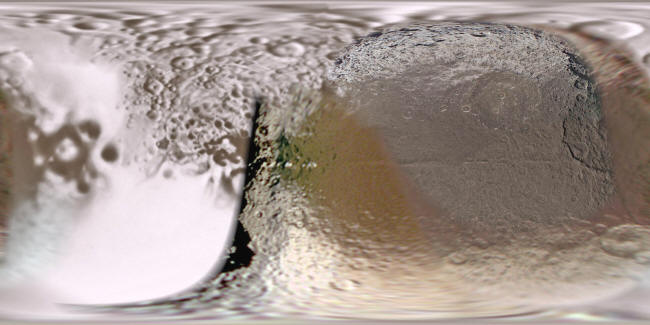
In previous sections of this series, we’ve presented a variety of
imaging (and other) evidence, from the on-going Cassini Mission,
that “something” about the eighth moon of Saturn is radically wrong:
that, after almost half a century of NASA’s looking, based on
multiple surface features and orbital parameters, Iapetus seems
increasingly unlikely to be a “purely natural moon” ….
Exhibit #1: the baffling, highly geometric, precisely equatorial ~
60,000-foot-high “Iapetus Wall.”
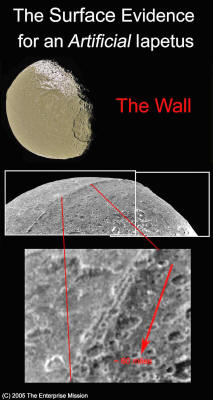
Exhibit #2: the equally astonishing, equally unnatural rectilinear
geometry -- evident all across the surface of this “moon”:
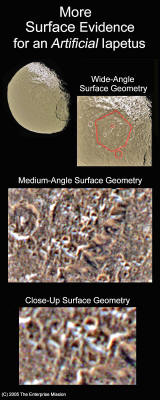
Exhibit #3: without doubt our most astonishing
Iapetus discovery –
unique (so far …) in the entire solar system:
That, instead of being spherical – as natural moons larger than
about 250 miles across must be (due to inexorable gravitational
contraction) -- the overall 900-mile-wide form of Iapetus is highly
geometric (below) … specifically, apparently an eroded truncated
icosahedron!
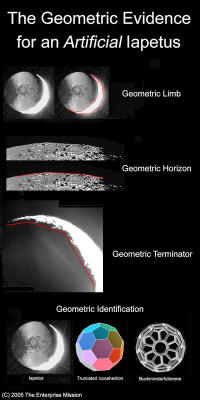
With this
brief review, we can now get to “the good part.”
As can be seen in this 1950’s classic (below), painted by another of
Arthur’s long-time friends – the “father of space art” himself,
Chesley Bonestell -- because of its highly tilted orbit, Iapetus is
the only “moon” with a spectacular perspective on both the Ringed
Planet … and all of Saturn’s other moons ….
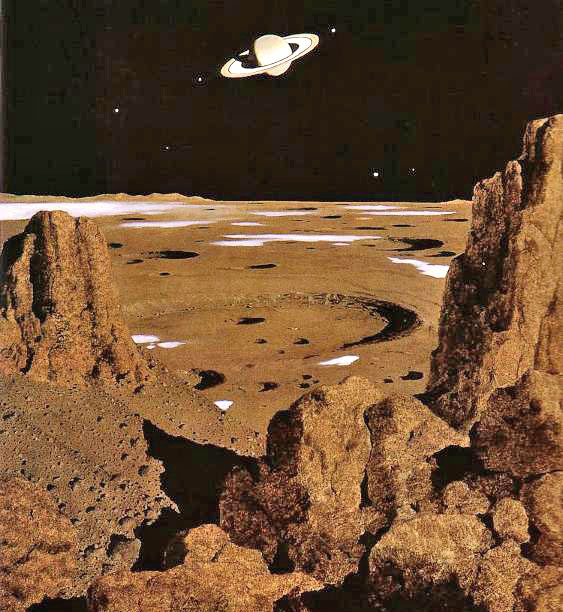
Considering that Chesley painted this evocative scene decades before
astronomers had anything to look at but a “winking” point of light,
the resemblance to the Iapetus that Voyager and Cassini have now
given us (below) is startling – right down to the leading
hemisphere’s “dark russet hue” ….
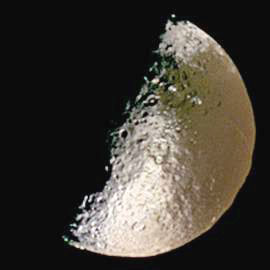
Which brings us back to the overarching, crucial question: just what
the hell is Iapetus … if it’s not just a “natural” moon!?
In
Part 5 we laid out two possible scenarios.
1) That, this extraordinary object was deliberately constructed as
an “ark” – an artificial, world-sized spacecraft -- designed to
rescue as many as possible from the imminent, hyperdimensional
explosion of an entire world, the destruction of a former major
member of the sun’s planetary system which now no longer exists:
Planet V. An event which would have inevitably, disastrously,
affected the very existence of even an extremely advanced, solar
system wide civilization … which we (and others) -- based on a
myriad of accumulating evidence -- have proposed arose long before
us … literally millions of years ago.
2) That Iapetus was indeed a “Deathstar world”
-- created as an
instrument of war by that same civilization (which is still humans’
primary occupation, isn’t it?) – an “instrument” then used in some
unimaginable conflict in this solar system a long, long time ago ….
That Iapetus may somehow have even been instrumental in creating the
almost unimaginable holocaust – a literal “war in Heaven” -- which
ultimately resulted in the deliberate destruction of that same
doomed world … with Iapetus itself caught by the aftermath. As an
eternal, silent tomb, forever trapped now in a permanent, unique
orbit around Saturn ….
But, as we hinted in earlier sections of this Series, there are
problems with both of these “solutions” to the current, increasingly
profound mysteries presented by Iapetus … major problems.
For instance, the density of this otherwise extraordinary “moon” is
awfully close to the density of several other Saturnian moons –
close to frozen water … ~1 gram/cubic centimeter. How (some critics
have asked) is that possible – if the intention was “to leave an
unmistakable, artificial marker in the solar system …?” Wouldn’t
such “designers” have wanted Iapetus’ density “to truly stand out?”
-- thus deliberately creating Iapetus with a measurable density
significantly less than water ice (by merely making the “moon”
bigger, in the “constructed” model, but with the same mass …).
If, indeed, this was the prime intention -- to uniquely signal its
artificial origin across the depths of space and time … to a distant
future generation – wouldn’t designers of such an “artificial world”
have made sure its density reflected that intent?
The answer, of course, depends on your definition of the term
“artificial.”
The fact is, we have never insisted that Iapetus was/is totally
artificial. Nor, that such an external signal to “a future
generation” was its prime reason for creation!
Even if Iapetus was a completely natural moon, and was subsequently
covered over with a series of deep, constructed artificial shells –
made of our suggested carbon nanotubes, and created in the geometric
form that we see in the Cassini imaging – the end product, in terms
of strict definitions, would most certainly qualify as “artificial!”
However, the impact of even such major surface modifications on the
natural moon’s total average density would still be almost trivial …
even for an artificial set of geometric “layers” extending into the
interior for literally miles ….
So, we began looking at a third possibility to explain the bizarre
existence of Iapetus, one which neatly – inherently -- resolves the
apparent contradictions of these first two tentative scenarios ….
And, then it struck us.
That -- some time before the destruction of Planet V -- in the
natural course of the inexorable expansion through and colonization
of the ancient solar system (by our posited “ancient, advanced human
civilization”) … Iapetus (as a previously natural moon, but one
laden with highly desirable raw materials) was specifically
transformed for another purpose altogether: from being just a
completely natural satellite … into an artificially-modified,
carefully crafted “designer world”… to serve as another highly
specialized purpose: as a vast, orbiting “hotel.”
Which was then moved from its original location (maybe in this
system, maybe farther out … Uranus … or Neptune … or even from the
so-called “Kuiper Belt”) -- to finally occupy the most coveted
location in the entire ancient solar system: a look-down orbit on
the most visually stunning (and
hyperdimensionally-significant)
planet known ….
Saturn!
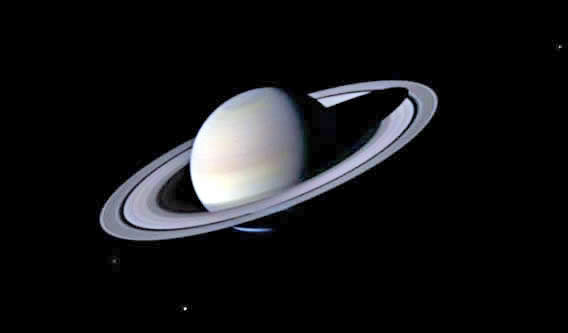
As … a created temple world …overlooking, for a Specific Spiritual
Purpose, the singularly most striking (and hyperdimensionally
“perfect”) planetary system known ….
A world where millions of ancient pilgrims, from all across the
inhabited solar system, once had to come … to meditate upon and
study -- in the most appropriate environment which could be created,
in the most appropriate location known – the ultimate Secrets of
Creation--
Truly … “a Moon with a View.”
Think about it.
If we are actually seeing in Iapetus “an ancient derelict … from a
long-forgotten time,” a battered relic of an extraordinary human
culture which once spanned this entire solar system – from
the
surviving, haunting, ancient ruins on Earth’s Moon, to
the
persistent architectural mysteries of Cydonia itself -- what would
have been more fitting than for that same technology and culture to
have created a unique habitat, in this most desirable location … a
specifically designed orbit overlooking the
most important planetary
example of hyperdimensional physics known … a front row seat on
Saturn?!
From Iapetus – a mere 2 million miles away, and orbiting 15 degrees
to its amazing rings – because of the immense size of this ensemble
(>140,000 miles across …), the astonishing, endlessly changing
spectacle would still have appeared eight times as large as a full
Moon (below) … rising over Earth’s horizon!
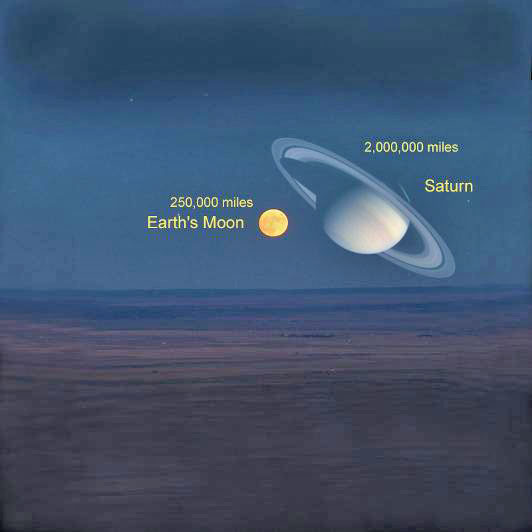
As such, it would be guaranteed to become an irresistible attraction
to any civilization ultimately capable of freely going there….
A prime 19th Century example: the famed Buddhist Temple, known as
“the Portola Palace,” built high in the Himalayas, in Lhasa, Tibet.

Also a prime destination for countless pilgrims, from all over the
world … for over a hundred years. A sacred destination constructed
-- for religious and ritual reasons -- in one of the most desolate
and inaccessible, but sacred, locations here on Earth (below) … the
literal “Rooftop of the World.”

This well-known human drive, for pushing out to new frontiers as
soon as it is technological feasible, to try to reach the most
inaccessible but special places … has now culminated in our own
century with
Dennis Tito’s much publicized 20-million-dollar private
pilgrimage (for, that’s what it truly was …) to the ultimate “sacred
outpost” -- the U.S. International Space Station (below).
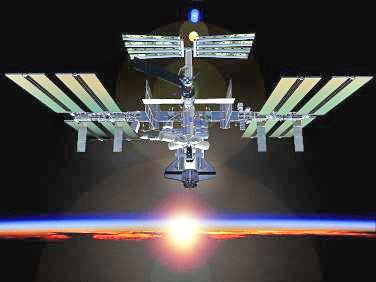
Future manifestations of this innate urge to seek out even more
extraordinary vistas and experiences, beyond this increasingly “tiny
world,” are manifesting in far more ambitious plans (after “only” 30
years …) --
for even more transformative and permanent experiences
beyond Earth orbit (below).
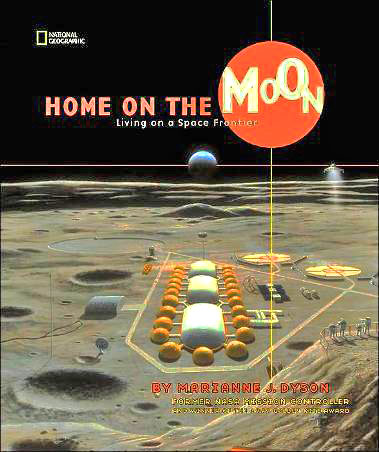
Against this uncontested backdrop -- an overwhelming human longing
for increasingly “ineffable experiences,” and coupled with its
proven technological capability to do whatever it takes to fulfill
that deeply ingrained “need” -- the emplacement of an ancient
“temple,” in an orbit around the most awesome (and, of course,
hyperdimensionally significant) planet of the entire solar system …
Saturn … for such an advanced civilization as we (and others) have
proposed … is not a “stretch” at all.
For, if Iapetus was designed as such a “temple world” – orbited at
its sacred (hyperdimensional) “base 60” distance and inclination,
and specifically modified to conform to this redundant “base 60” hyperdimensional connection, even in its overall dimensions and
geometry – such a scenario would neatly answer all the baffling,
currently unanswerable characteristics of Iapetus ….
Which the “deathstar” or “rescue ark” scenarios cannot.
Given that a technological prowess capable of this once spanned the
ancient solar system (admittedly, a big “given,” but one based on
ample additional evidence -- such as the miles-high glass ruins on
the Moon), why not eventually find -- as part of such an obviously
sophisticated, multi-faceted, far-flung technological culture – the
remains of a literal “orbiting temple to hyperdimensional Geometry
and Physics?”
Far less technological peoples, in our own immediate past (on this
one planet), have repeatedly expended prodigious (and equally
baffling, to anthropologists and archaeologists) social and
engineering efforts – from Stonehenge to Giza ... to
Chaco Canyon --
to immortalize remarkably similar religious and spiritual concepts
….

Why not our most ancient (and, compared to us, much more
hyperdimensionally-connected) almost “godlike” ancestors …?
An orbiting world, specifically shaped -- as part of their inherent
“cosmological World View” – as a constant reminder for how Humanity
… how the solar system … how the Universe itself … came into literal
Three-Dimensional Existence!?
The Ultimate expression of “as Above … so Below?”
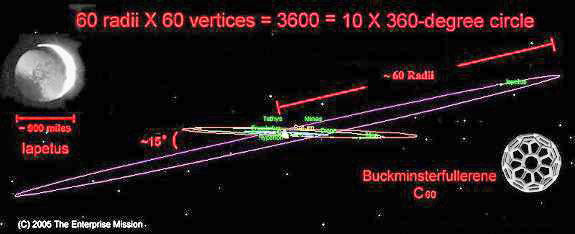
Again, we have innumerable precedents for such spiritual
“mega-engineering” on this planet – sacred architecture that,
according to many independent researchers, has intimately encoded
these same “sacred" geometry and hyperdimensional principles in the
most mysterious, surviving wonders on this world ….
According to researcher, Bernard Pietsch:
“… the proposition [is that] that the designers of the
Great Pyramid
had access to a supremely successful paradigm subsequently lost to
later generations. The Pyramid is the database of that lost
paradigm. As a library in stone, it is designed as a model of the
galaxy, the solar system, the earth and ultimately the human being.
It is a working metaphor of astronomy, physics, biology, and earth
science. The Pyramid is [on Earth] the consummate demonstration of
"as above, so below …."

The question has always hovered over these amazing ruins, all around
the world – “From how far back in time … and from where … did such
‘advanced’ ideas, and incredibly sophisticated knowledge, enter into
human consciousness? And … from whom?”
Are we on the verge of finally Knowing?
Some years ago, Michael Cremo and Richard Thompson published a
voluminous compendium of startling examples of additional “lost
archaeological knowledge,” in a landmark work entitled “Forbidden
Archaeology.” Here’s one reviewer’s description:
“Over the past two centuries researchers have found bones and
artifacts showing that people like ourselves existed on earth
millions of years ago. But the scientific establishment has ignored
these remarkable facts because they contradict the dominant views of
human origins and antiquity. Cremo and Thompson challenge us to
rethink our understanding of human origins, identity, and destiny.
Forbidden Archeology takes on one of the most fundamental components
of the modern scientific world view, and invites us to take a
courageous first step towards a new perspective [emphasis added].…”
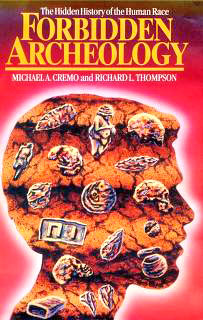
One of the most remarkable examples of potential ancient artifacts
published by Cremo and Thompson were hundreds of “small, grooved
spheres” – mined in South Africa. According to Roelf Marx, curator
of the Museum of Klerksdorp, South Africa, where some of the spheres
are housed:
“The spheres are a complete mystery. They look man-made, yet at the
time in Earth's history when they came to rest in this rock no
intelligent life existed. They're nothing like I have ever seen
before (Jimison 1982).”
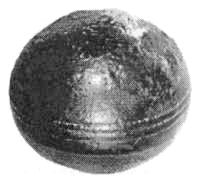
One of the most compelling arguments for
artificiality of
these
perplexing spheres is a set of three (!) parallel grooves around
their “equators” (above); that -- and the equally remarkable
hardness of the (currently unknown) material from which they are
made ….
Again, Roelf Marx:
“… they are found in pyrophyllite, which is mined near the little
town of Ottosdal in the Western Transvaal. This pyrophyllite
(Al2Si4O10(OH)2) is a quite soft secondary mineral with a count of
only 3 on the Mohs' scale and was formed by sedimentation about 2.8
billion years ago. On the other hand the globes, which have a
fibrous structure on the inside with a shell around it, are very
hard and cannot be scratched, even by steel [emphasis added] …."
Actually, pyrophyllite is a mineral created by metamorphism of
earlier sediments, at moderate temperature and burial depths of
several miles. The most astonishing, if undisputed fact (because of
the highly specific dating of the pyrophyllite rock layers in which
these “spheres” were found) is their extraordinary age: 2.8 billion
years!
Whatever formed them (and then left them for two thirds of the
history of planet Earth, in this extremely ancient metamorphic rock
deposit!), occurred when the highest forms of life on Earth were
only red and blue-green algae! So -- how did hundreds of precisely
crafted, apparently intelligently-designed metallic artifacts,
harder than steel, find their way into such a deep rock layer …
literally miles below South Africa?!
But, that isn’t the most remarkable part of this story.
Other images of these mysterious “metallic spheres” in the Klerksdorp Museum (below) reveal an even more astonishing, precise
resemblance to none other than the Cassini close-ups of the
anomalous eighth satellite of Saturn–
Iapetus!
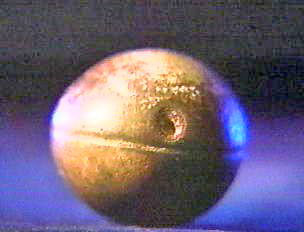
These remarkable details include not only the same “equatorial
ridge/groove” … but the presence of a “deathstar entry port" as well
(below)!

This close-up (below) illustrates the scale of these astonishing
~3-billion-year-old analogues, compared to their vastly larger
“cousin” … over a billion miles away.
How could this astonishing similarity naturally occur?!
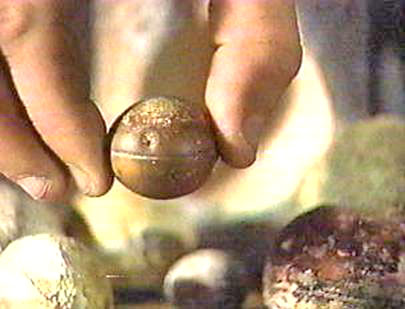
Keeping in mind that Forbidden Archeology was initially published in
1993, yet the Cassini Iapetus’ close-ups did not come in until
January, 2005 -- this eerie parallel demands far more than another
casual dismissal as “just coincidence.”
In fact, there is in this discovery a startling, potential “fourth
explanation” for Iapetus. But … it is not an explanation anyone will
easily accept ….
It is now known that for most of the history of Earth, the most
sophisticated form of life was simple algae – “pond scum.” From
about four and a half billion years ago up until about six hundred
million years before the Present, a relatively narrow range of algae
were the most advanced organisms living anywhere on the planet.
Then, at the boundary between the last two great geological epochs
-- known as the great “Pre-Cambrian/Cambrian transition” -- there
was a veritable “explosion” of much more complex life … which formed
the pattern for the development of all the future “kingdoms,”
“phyla,” “genera,” “families” and “species” that we now recognize on
Earth.
This so-called “Cambrian Explosion” is without doubt the single
biggest mystery of life on Earth—
Save, of course, for the even more mysterious
appearance of Life
itself.
Why, for literally billions of years, was Earth home to only an
extremely narrow range of microscopic cyanobacteria, some organized
in great algal mats (below) called “stromatolites” … ? And then, in
the space of less than 5 million years (as judged by the latest
evidence) – BANG!! – every form of life currently appearing on Earth
suddenly emerged …?
In fact, this profound mystery is termed by some biologists “the Big
Bang of Evolution.”
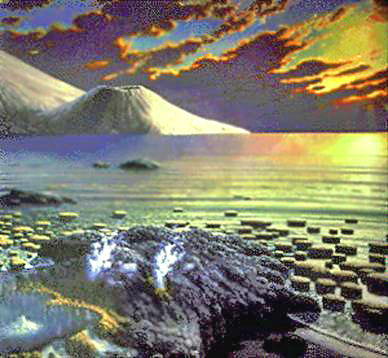
The discovery of manufactured artifacts -- looking exactly like what
we now know Iapetus to be -- and in the middle of this incredibly
ancient, incredibly primitive Pre-Cambrian Epoch … is simply
impossible.
Unless—
They were brought here from “somewhere else” -- when those original
sediments were being formed ….
Which, of course, introduces the idea of “seed ships.”
In the last ten years, a major scientific revolution has quietly
occurred: astronomers have, for the first time, indirectly detected
(via highly sensitive application of the well-known “Doppler
technique”) over 150 actual “exoplanets” … non-stellar worlds,
orbiting nearby stars!
The
most recently announced discovery (June 13, 2005) is getting
very close to the “Holy Grail" of these pioneering surveys: the
detection of the first “Earth-sized,” rocky world beyond the solar
system. All previous discoveries over the past decade have been of
so-called “gas giants” – planets ranging from about twenty times
Jupiter’s mass ... down to just about Uranus and Neptune-sized
worlds.
The latest Doppler confirmation of a “6-8 Earth-mass planet …
orbiting about two million miles from its low-mass, red dwarf parent
star …” – Gliese 876 – ranks as a major step forward in finally
placing our own solar system -- and its diverse population of both
gas giants and smaller, rocky worlds -- into proper astrophysical
perspective. [There were already two Jovian-sized worlds orbiting
within the Gliese 876 system, which lies
15 light years away in the
direction of Aquarius, detected some years earlier (see artists’
conception, below)].
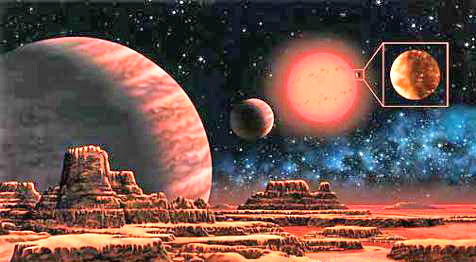
When the first of these startling “exoplanets” was announced -- some
ten years ago, in October, 1995, orbiting another nearby star (“51 Pegasi,” 50 light years away in the direction of the constellation
Pegasus) -- it really shocked the astronomical community.
For, the
data revealed the object (“51 Pegasi b”) to be about half the mass
of Jupiter … but whipping around its sun-like star every 4.23 days
(see schematic, below).
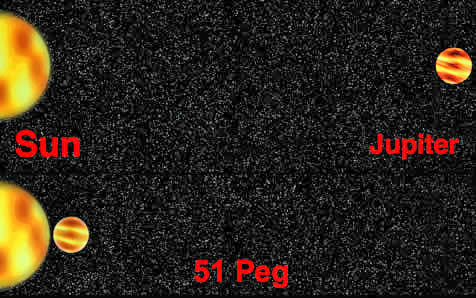
Jupiter takes 11.86 years to orbit the Sun -- once.
So startling was this 51 Peg orbit that, for some time after the
initial announcement in Geneva, there was
serious debate over its
reality. Eventually, the controversy was settled in favor of the
data, that the first extra solar planet was indeed real, and … was a
massive “Jovian-type” world in a bizarre orbit.
Because, most remarkably (as can be seen above), 51 Pegasi b had to
be orbiting extremely close in (from application of Kepler’s Laws to
the Doppler-shifted spectrum of 51 Pegasi a) – less than 5 million
miles from the star itself (1/6 the distance between Mercury and the
Sun)! This is so close, that the planet’s upper atmospheric
temperature (not directly measurable via this technique, but
calculated) is several thousand degrees F! At these temperatures,
“clouds” would consist of metallic vapors, the planet tidally locked
into unchanging geometries of searing “day” in one hemisphere,
perpetual “night” in the other … and “eternal sunset” in-between
(below).

Thus was born the exoplanet term “hot Jupiter” -- to describe MOST
of these now-discovered ~150 plus worlds currently known to exist
around other suns …
almost all of which seem to be circling their
stars either extremely close-in … or, in wildly eccentric orbits.
Both properties are the “lethal” difference between the “normal”
distances and behavior of the planets in our solar system, and 99%
of the so-far discovered “extrasolar worlds.” Put another way, star
systems containing planets orbiting around them in orderly
configurations (and distances) similar to Mercury, Venus, Earth,
etc. -- with additional gas giants located safely far from the inner
planets and their parent star (like Jupiter, Saturn, etc.) – so far
appear extremely rare … less than 1%.
The reasons for these major “exo-solar-system” anomalies (compared
to the orbit spacing this solar system) are still totally unknown.
What these (admittedly early) planetary statistics seem to be
telling us is that Earth-like, habitable planets around other stars,
orbiting within equally “friendly,” highly ordered solar systems
(like this one) – thus, possessing environments capable of
supporting the long-term evolution of “life among the stars” -- must
be quite rare ….
So, enter Iapetus … again.
The fourth (and most striking) possibility for the existence of this
profoundly bizarre, 900-mile, highly modified “base 60 world” –
endlessly pursuing its precise “base 60” orbit around the most
remarkable planet of this solar system – is that Iapetus was once
part of an ancient, extraterrestrial program to convert this system
of planets (among how many others in this Galaxy…?), from one of
those myriad uninhabitable systems astronomers are finding--
Into a Special Place ….
Which could one day support the origin and evolution of Conscious
Life around our Sun!
That Iapetus was, indeed—
An ancient “seedship” … from the Stars.
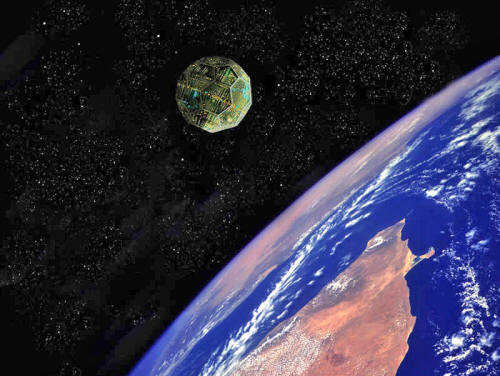
There is no space here to provide the literally years of
documentation we have painstakingly assembled in support of this
(admittedly) extraordinary hypothesis. That will come later. Suffice
to say that the incredible identity – between Iapetus “the moon,”
and the tiny, mirror-image “replicas” found inexplicably in rock
strata laid down billions of years ago on Earth – argues
convincingly that there could be some kind of link between the two.
What that specific link might be must await further, in-depth
research – both into the true nature of Iapetus ... and
the
“spheres” discovered in South Africa.
But, that’s what makes this science: this is an idea (no matter how
“far out”) which can be tested ....
However, even with what we know now, the data is compelling:
The discovery of
“spongy” and “charcoal-like” material inside many
of these spheres, coupled with the extreme hardness of their shells,
is completely consistent with the idea that these objects could have
been originally intended as some kind of “protective carriers” --
for organic or biological materials!
If part of a systematic extraterrestrial program to “seed” life
across the Milky Way, on previously lifeless worlds (like Earth!),
such small devices could have been automatically produced elsewhere
in this solar system (by the billions), to function similar to
natural seed carriers known to biologists today -- a LOT of “seeds”
disseminated … for every successful “implantation.”
The eerie resemblance to Iapetus could then have been far more than
mere “coincidence” but, was perhaps specifically intended as,
1) the
means to identify different teams and seeding programs (ships?),
operating on different planets and environments across the ancient
solar system, or
2) to let the descendents of this “grand
experiment” (when they arose … and eventually discovered even a few
of the literally billions of surviving “seed” shells …) to someday
successfully trace their origins--
All the way to Saturn!
Isotopic analysis -- of both Iapetus ... and these strange,
terrestrial “spheres” -- could provide specific information
essential to confirming or falsifying this entire
“directed panspermia” hypothesis. As could biological analysis of what’s
inside ….
In 1973, molecular biologists Francis Crick and Leslie Orgel
formally proposed in the mainstream planetary science journal,
Icarus [Crick, F. H. C., and Orgel, L. E. "Directed Panspermia,"
Icarus, 19, 341 (1973)] that
life on Earth could be the direct
result of such an interstellar “seeding program.” Their idea was the
essence of simplicity -- once the “small problem” of building
interstellar spacecraft essential to carrying the “seeds” across
interstellar space was overcome by “a suitably advanced
civilization”:
“The spaceship would carry large samples of a number of
microorganisms, each having different but simple nutritional
requirements, for example, blue-green algae, which could grow on CO2
and water in ‘sunlight.’ A payload of 1,000 kg might be made up of
10 samples each containing 1016 microorganisms, or 100 samples of
1015 microorganisms ….”
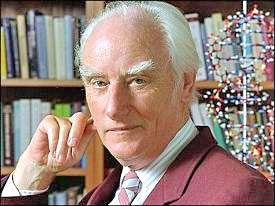
Crick was co-winner of the 1962 Nobel Prize in Medicine, for his
co-discovery (along with James Watson and Maurice Wilkins) of the
fundamental “building block” of life on Earth, DNA. In his and Orgel’s historic 1973 Icarus paper, Crick made several key comments
about the more curious aspects of the DNA “code of Life” – which
would be neatly solved if “directed panspermia” had indeed brought
the first living microorganisms organisms to this planet.
Said Crick:
“Several orthodox explanations of the universality of the
[terrestrial DNA] code can be suggested, but none is generally
accepted to be completely convincing. It is a little surprising that
organisms with somewhat different codes do not coexist. The
universality of the code [on Earth] follows naturally from an
‘infective”’ theory of the origin of life. Life on Earth would
represent a clone derived from a single set of organisms [emphasis
added]….”
The larger problem, of course, is the increasing mathematical
impossibility in the molecular biological community of deriving DNA
from random thermodynamic processes limited to Earth – even over the
literally billions of years that the evolutionary biologists now
claim this occurred.
About a decade after proposing in Icarus that life scientifically
appeared to him to have originated from “somewhere beyond Earth” …
and then was deliberately brought here, by “someone,” Crick raised
the even more fundamental DNA objection to Life’s origins on Earth
alone. Writing in a book dedicated to these major mysteries (Crick,
Francis, “Life Itself,” Simon & Schuster, N.Y. 1981),
Crick noted
the almost insuperable chemical problems of naturally forming DNA on
even an ancient Earth, as prerequisite to subsequently evolving even
simple one-celled organisms:
“… an honest man, armed with all the knowledge available to us now,
could only state that in some sense, the origin of life appears at
the moment to be almost a miracle, so many are the conditions which
would have to have been satisfied to get it going [emphasis added]
….”
By removing the sticky question of life’s ultimate origins to a
completely separate location in the Galaxy, with uniquely favorable
(if currently unknown) conditions, and replacing its “miraculous”
appearance on this planet with a secondary “seeding” scenario from
somewhere else, Crick was attempting to salvage the central tenant
(and rising problem) of all contemporary evolutionary biology: that
Life even has a “natural” origin!
What he was trying to say scientifically, was “Yes—
“It just wasn’t … here.”
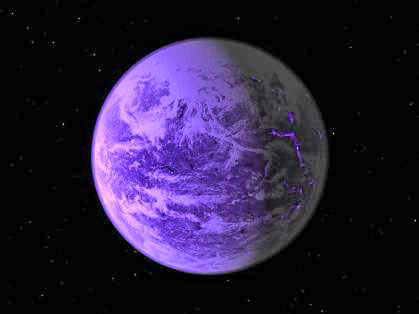
Again, we do not have room to debate the full details of
Crick and Orgel’s panspermia theory. What we do have is brand new evidence,
which they did not possess–
That provides a stunning new line of research into their seminal
idea.
Because -- parked in a unique “base 60” orbit, around the most
spectacular “hyperdimensional planet” of this solar system -- is an
apparently ancient, geometrically altered world … battered almost
beyond recognition. Astoundingly -- a billion miles away, buried
deep within this planet -- lie a set of miniature counterparts ...
from a long, long time ago ….
This stark “coincidence” now demands serious investigation!

Earlier, we alluded to the one critical factor which would totally
invalidate the Crick/Orgel hypothesis: “the ‘small problem’ of
building practical interstellar spacecraft” … critical to any
“planetary seeding” across interstellar space.
In the 1970’s, when Crick and Orgel initially proposed their
“directed panspermia” hypothesis, the physics (to say nothing of the
engineering!) of interstellar travel was considered impossible by
the overwhelming majority of mainstream scientists. Einstein’s
Special Theory of Relativity – which appears to prohibit spatial
travel in three dimensions “faster than c” (light speed) -- and the
simple fact of the immense interstellar distances (light years)
between potentially habitable star systems, created what many termed
“God’s Quarantine regulations.”
But, in the ensuing thirty years since 1973, mainstream physics has
proposed a variety of extraordinary new hypotheses regarding space
and time – some of which provide serious “loopholes” in these
previously inviolable “quarantine constraints.”
By a remarkable “coincidence” -- just as Cassini was sending home
its astonishing first close-ups of Iapetus -- a group of mainstream
physicists
published a landmark re-analysis in a major international
scientific publication on the feasibility of “interstellar
visitations” to Earth -- based on these new physics. Titled
“Inflation-Theory Implications for Extraterrestrial Visitation,” and
published in the January/February issue of the peer-reviewed Journal
of the British Interplanetary Society, the new analysis was authored
by astrophysicist Bernard Haisch, along with physicists James Deardorff,
Bruce Maccabee and Harold Puthoff.
Bernard Haisch says this about the new study:
“What we have done is somewhat of a breakthrough. We have pulled
together various recent discoveries and theoretical issues that
collectively point to the strong probability that we should be in
the midst of one or more huge extraterrestrial civilizations
[emphasis added] ….”
The authors’ central thesis comes down to this:
“It has recently been argued that anthropic reasoning applied to
inflation theory reinforces the prediction that we should find
ourselves part of a large, galaxy-sized civilization, thus
strengthening Fermi’s paradox concerning ‘Where are they?’
Furthermore, superstring and M-brane theory allow for the
possibility of parallel universes, some of which in principle could
be habitable. In addition, discussion of such exotic transport
concepts as ‘traversable wormholes’ now appears in the rigorous
physics literature. As a result, the ‘We are alone’ solution to
Fermi’s paradox, based on the constraints of earlier 20th Century
viewpoints, appears today to be inconsistent with new developments
in our best current physics and astrophysics theories.
Therefore we
reexamine and reevaluate the present assumption that
extraterrestrials or their probes are not in the vicinity of Earth,
and argue instead that some evidence of their presence might be
found in certain high-quality UFO reports.
This study follows up on
previous arguments that,
(1) interstellar travel for advanced
civilizations is not a priori ruled out by physical principles and
therefore may be practicable
(2) such advanced civilizations
may value the search for knowledge from uncontaminated species more
than direct, interspecies communication, thereby accounting for
apparent covertness regarding their presence [emphasis added]….”
Quite apart from theory,
in the official Russian News and
Information Agency (RIA Novosti), this past Spring, the head of the
R&D Institute of Space Systems, Valery Menshikov, announced an
engineering breakthrough of precisely such a non-rocket based,
“field propulsion technology” – for eventual use aboard the Russian
section of the International Space Station, and on other Russian
missions:
“ … the R&D Institute of Space Systems ... is busy developing a
perpetuum mobile (perpetual-motion engine), of sorts. This engine
that will have a virtually unlimited service life could be used on
Earth and in outer space."
“… a liquid or solid-state propulsive mass moves along a preset
tornado-shaped trajectory inside this engine, thereby ensuring
sustainable propulsion. Quite possibly, we are witnessing a hitherto
unknown interaction between the propulsive mass and little-studied
fields, including the gravitation field [emphasis added] ….”
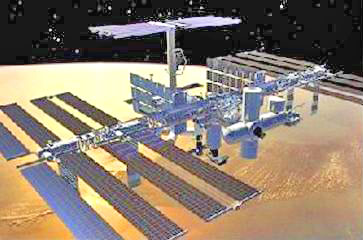
A major American clearing house for these revolutionary physics and
engineering developments quietly taking place around the world, is
The American Anti-Gravity Foundation -- which tracks current
“anti-gravity” research through direct interviews with major workers
in the field, published technical papers, and status reports from a
wide variety of leading governmental and private sector (including
major corporate) researchers.
This astonishing compendium – both theoretical physics breakthroughs
and actual “gravity engineering” – curiously ignored by mainstream
journals and media outlets (with some singular exceptions – such as
the recent Russian News Agency story …), is publicly accessible
world-wide on the
American Anti-Gravity website.
One of those breakthroughs is a thorough reanalysis of the major
“physics failure” of the 20th century – the widely reported
“inability of even Albert Einstein” to come up with a workable
“Unified Field Theory” (UFT) combining gravity and
other forces,
before his death in 1955.
In fact, according to American Anti-Gravity documents, this is
simply NOT true: well before his death, Einstein DID succeed in
producing a viable (and radically simplified!) theory of gravity ...
which was not only experimentally confirmed by other scientists and
engineers of the period, but is now leading to several breakthrough
engineering developments re gravity control!
According to one key “insider”:
“The modern (mainstream) physics community insists on making a
fundamental error in their attempts to unify the fundamental forces.
Some day a scientist is going to get a Nobel prize for what I am
about to [say] ….
“The mistake with modern unified field theories is that they are
working under the false belief that gravity only links with the
other interactions at exceedingly high energies. In other words, the
type of extreme conditions that existed a tiny fraction of a second
after the Big Bang. At that short instant, gravity and
electromagnetism -- and the other forces -- are all interchangeable,
they are all more or less indistinguishable. One might say at this
point there is a clear interchange between electromagnetic and
gravitational forces; they are strongly coupled, or inductively
‘linked,’ at this condition.
“Right there, is the error in modern gravity theories: the
assumption of ultra-high energies! Gravity and electro-magnetism are
linked at low energies. Gravity and electromagnetism are coupled
together in conditions that can be as ‘everyday’ as those inside a
whirling polyphase electrical motor. In fact, one way of thinking of
an antigravity device is to think of it as an unusual form of
electrical motor [emphasis added].
“With this in mind, consider some of the [currently obscure]
contributions that Einstein made towards anti-gravity ….

“1) He recognized the inherent limitations of
...General Relativity
[GRT] and sought to correct those. “The [Einstein]
unified field
theories [UFT] are his improved theory of gravity. Gravity and EM
are brought together as a result of a radical new concept of space.
This is an amazing approach …. Einstein emerges into a truly
breakthrough realm: General Relativity gave us non-Euclidean space
... but UFT goes to non-Euclidean and non-Riemannian [beyond
four-dimensional ‘space-time’] space. This is constantly ignored by
writers who trash [his] UFT. They ignore that Einstein had said GRT
was ‘only an approximation that dealt with gravity’ and as such, a
theory he was not [ultimately] satisfied with .…
“2) His UFT introduces the idea of ‘sub-space’ or ‘hyper-space.’
“Modern theories talk of ‘hidden dimensions’; Einstein's UFT has
something different. He says that there is a space out of which our
space-time -- including any hidden dimensions – is ‘constructed.’
The idea is thus a space structure that transcends [or underlies]
our own. Or ... expressed differently … that our space-time is a
limited sub-set of – or geometric projection of -- this more
fundamental [space] structure ….”
Sounds an awful lot like “Hyperdimensional Physics” to me ….
“3) … Einstein introduces the concept that
...only the vector magnetic
potential has a physical reality in electrodynamics, the electric
and magnetic fields are merely concepts we have developed due to
reciprocity of the field. Most modern physicists still do not accept
this assertion of Einstein ... although more recent experimental
research -- the Arahnov-Bohm experiment -- suggests that the
A field
is real (the experiment shows that A can alter the quantum wavefunction … [even] when all other EM effects have been completely
shielded out).
“Finally, here is an interesting thought: the A field appears to cut
through shielding, and [still] effect matter [even]when all normal
forms of the EM field have been excluded. Controversial research
suggests that changes in an electron's quantum wavefunction, induced
by the A potential, is identical to what a ‘psychic’ does by
concentrating on an electron interference experiment.
“In other words ... maybe
Einstein's UFT might also be related to
psychic effects!
We have, in just the last few days, discovered dramatic experimental
support for precisely this astonishing proposal: evidence that
“anomalous cognition” (as “ESP/psychic” experimentation is now
termed) is dramatically affected (by up to 600%) by key parameters
of
hyperdimensional physics!
Again, there is no room to provide the
critical documentation here; that will be done in a future paper on
Enterprise, on this specific subject.
“4) … Einstein invents the Einstein/Szilard refrigeration system
(what is this doing here? Well, just wait!).
“Very few people are even taught that Einstein was an
experimentalist and an inventor. This refrigerator is possibly the
first application of magneto-hydrodynamics [MHD]; it uses AC
magnetic fields to create MHD forces in liquid metals. The metals
are pumped around through a heat exchanger. But … look at the story
beneath the obvious .... Here we have Einstein using AC inductive
fields to circulate liquid metals: strangely similar to some current
antigravity concepts …. His system is [also] oddly similar to two
experiments that produced an [actual] ‘AG type effect’ – one of them
you will never hear about, even in the fringe community… but it
happened at an AEC [Atomic Energy Commission] facility in the 1960's
….
“5) Einstein develops experimental methods
...to study UFT predictions
and does this right at the same time he is doing experiments for
things like the D'Hass-VanAlfven Effect, and Einstein D'Hass Effect.
“In these effects, we have a study of diamagnetism and the
magnetization of spinning objects -- bismuth samples – materials we
have [also] heard about in various antigravity projects. These
experiments get into some very fascinating areas, that show that
spinning or precessing atoms can store energy in a field, and the
field can collapse and re-spin the whole sample! So, we have
spinning diamagnetic materials and EM fields being a known area of
experimental investigation for Einstein: yet one more similarity to
certain AG stories ….
What are the first “Three Laws” of Hyperdimensional Physics again …
“rotation … rotation … rotation …?”
“6) Einstein
actually predicts antigravity!!!!
“Right here, this ought to be enough to really turn the heads of the
conservative mainstream crowd …. In personal correspondence in the
early 1930's, Einstein openly speculates that UFT will lead to some
form of “propulsion.” Think of the implications of that! He is the
man who revolutionizes our understanding of gravity … and ‘Einstein
the inventor’ sees in his equations the probability of antigravity!
And yet most physicists in the mainstream -- and certainly most in
the AG fringe -- would (incorrectly) assert that Einstein's theories
show no possibility of AG! How wonderfully ironic!
“7) Einstein receives a confirmation of his UFT.
“‘[Gabriel] Kron's equations’ are the only ones able to predict and
explain the strange behavior of ‘synchronous machines’
[synchronized, rotating electric motors and other spinning
electrical devices]. UFT effects -- including EM induced torsion and
curvature fields -- are the explanation for strange anomalies [in
these massive rotating systems] like ‘phase slip,’ ‘creep’ and the
bizarre effect of ‘hunting.’
“And who is interested in Kron's theories?
“The US Navy – because they want to use the [rotating] power
selsyns
and amplidynes onboard ships. So Kron's practical form of Einstein's
equations proves the validity of UFT. This again is still utterly
lost on the mainstream crowd, and sadly wasted on [parts of] the AG
crowd ….
“8) Einstein works for the Navy during WW-II.
“His office mate is JD
Krauss. I don't even know how to begin with this one .... All I
suggest is just look at Krauss' legacy ... the areas he worked in
practically shout ‘radar invisibility!’ Those two must have had some
amazing sessions. The Navy was the one service with high value
assets, that were large enough and had enough power to try some wild
things ... I am convinced those two cooked [up] ideas about how to
use high-power AC magnetic fields to deflect and disable mines and
torpedoes, and how a big AC field could alter and ‘stealth’ the
L-band radar cross- section of a ship.
I think Kron and John Moore
did the analysis on the generators, and Tesla MIGHT have been used
as a short term consultant to do a resonant circuit to further amp
up the field created by the modified degaussing coils. John VonNeumann probably did the analysis of effects on
RCS [radar cross
section], and Donald Menzel looked at the optical and atmospheric
effects. Vannevar Bush talked the Navy into the project. [Bush and Menzel also worked together after the war on what we would now call
‘foreign threat assessment’ (very foreign) ….]
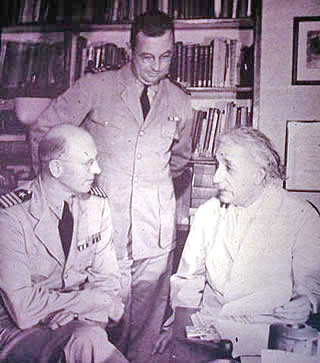
“9) And in 1943, Hoffman at Princeton in a public lecture
... about Kron's version of the
UFT … says ‘we now have experimental
confirmation of Einstein's Unified Field Theory.’ He was talking
about the effects in motors ... but, he means what he says.
Einstein's theory of a [low energy!] relation between
‘electromagnetism and gravity’ has been proven – because of
observable effects it predicts in [rotating] motors …."
-- Note: This information was provided on background by a scientist
working at a small aerospace engineering and advanced technology
company in Cypress, California who wishes to remain anonymous...
Rotation … rotation … rotation ….
So ... what does all this have to do with
Iapetus?
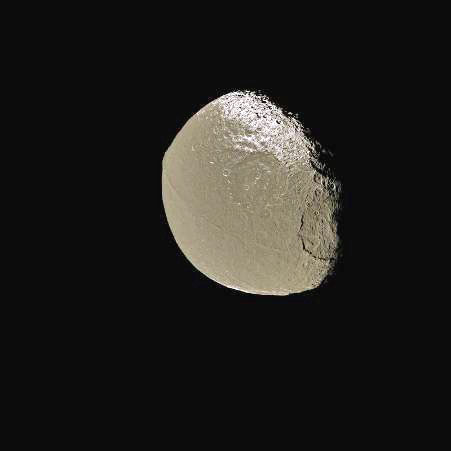
Simple.
If Iapetus is a modified moon/spacecraft, developed by an advanced
interplanetary/interstellar civilization … then it is foreordained to have embodied
physics and engineering far beyond of any current capabilities or
even theories.
Ergo: it was NOT propelled by “rockets.”
If Einstein’s UFT ideas, or any of the modern variants which have
evolved -- from super strings to M-brane theory – can ultimately be
engineered into workable technologies for literally bending space
and time ... then, all bets are off. Anything could be waiting
inside Iapetus … if we return.
Only one thing now seems clear:
Whoever designed it, for whatever ultimate objective, if our
“insider” physicist is correct in observing “…one way of thinking of
an antigravity device is to think of it as an unusual form of
electrical motor …”, then the mystery of Iapetus
~60,000-foot-high“wall” may now be close to resolution—
As the massive field coils of a world-sized, anti-gravity propulsion
system ... which may have literally carried Iapetus between the
stars … setting in motion a series of extraordinary events,
stretching across literally billions of ensuing years … which would
one day lead to us!
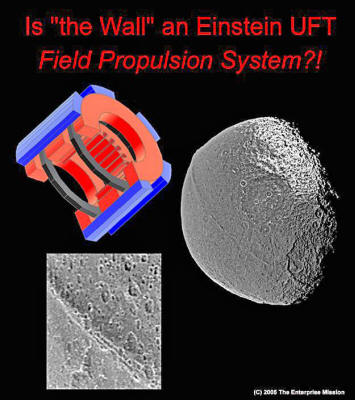
If that is true, then its very name – “Iapetus” … the father of
Prometheus, the “maker of Mankind” --- is eerie foreshadowing of all
we might one day confirm ….
Could that stark possibility – that, in
Iapetus, we are confronting
our very origins … if not the origins of every living thing on Earth
-- explain the startling series of events … from
the Vatican to
Washington DC … that Cassini’s shocking close-ups set in motion at
the turning of 2005?
Click Here for Part Seven
→
|
































